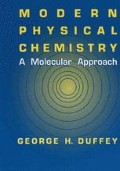Abstract
THE CHEMICAL PROPERTIES OF ELEMENTS correlate with their low lying electron configurations. The inertness of the rare gases He, Ne, Ar, Xe, Rn implies that their electron configurations are particularly stable. So when two elements react to form an ionic compound, the resulting electron configurations tend to be those of nearby inert gases. When atoms combine to form covalent bonds, the shared electrons tend to complete the pertinent subshells to also give inert gas configurations.
Access this chapter
Tax calculation will be finalised at checkout
Purchases are for personal use only
Preview
Unable to display preview. Download preview PDF.
References
Books
Carsky, P., and Urban, M.: 1980 Ab Initio Calculations: Methods and Applications in Chemistry, Springer-Verlag, Berlin, pp. 1–241.
Del Re, G., Berthier, G., and Serre, J.: 1980 Electronic States of Molecules and Atom Clusters: Foundations and Prospects of Semiempirical Methods, Springer-Verlag, Berlin, pp. 1–177.
Douglas, B. E., and Hollingsworth, C. A.: 1985 Symmetry in Bonding and Spectra, Academic Press, Orlando, Fl, pp. 1–253.
Hinchliffe, A.: 1988 Computational Quantum Chemistry, John Wiley & Sons, Inc., New York, pp. 1–112.
Lowe, J. P.: 1978 Quantum Chemistry, Academic Press, New York, pp. 135–571.
Simons, J., and Nichols, J: 1997 Quantum Mechanics in Chemistry, Oxford University Press, Oxford, pp. 123–185.
Articles
Baird, N. C.: 1986, “The Chemical Bond Revisited,” J. Chem. Educ. 63, 560–664.
Blaise, P., and Henri-Rousseau, O.: 1988, “Variational Energy Lowering May Increase Hamiltonian Dispersion,” J. Chem. Educ. 65, 9–11.
Bratsch, S. G.: 1988, “Revised Mulliken Electronegativities I, II,” J. Chem. Educ. 65, 34–41, 223–227.
David, C. W.: 1991, “Computing Overlaps between Nonorthogonal Orbitals,” J. Chem. Educ. 68, 129–130.
DeKock, R. L., and Bosma, W. B.: 1988, “The Three-Center, Two-Electron Chemical Bond,” J. Chem. Educ. 65, 194–197.
Dias, J. R.: 1987, “Facile Calculations of the Characteristic Polynomial and,r-Energy Levels of Molecules Using Chemical Graph Theory,” J. Chem. Educ. 64, 213–216.
Dias, J. R.: 1992, “An Example Molecular Orbital Calculation Using the Sachs Graph Method,” J. Chem. Educ. 69, 695–700.
Duke, B. J., and Leary, B.: 1995, “Non-Koopmans’ Molecules,” J. Chem. Educ. 72, 501–504.
George, P., Bock, C. W., and Trachtman, M.: 1984, “The Evaluation of Empirical Resonance Energies as Reaction Enthalpies with Particular Reference to Benzene,” J. Chem. Educ. 61, 225–227.
Hofmann, H. F.: 1997, “A Dynamical Model of the Chemical Bond: Kinetic Energy Resonances between Atomic Orbitals,” Eur. J. Educ. 18, 354–362.
Hollingsworth, C. A.: 1991, “Degeneracies in Separable Systems with 0h Symmetry,” J. Chem. Educ. 68, 23–24.
Karafiloglou, P., and Chanessian, G.: 1991, “Understanding Molecular Orbital Wave Functions in Terms of Resonance Structures,” J. Chem. Educ. 68, 583–586.
Keeports, D.: 1986, “A Comparison of Molecular Vibrational Theory to Huckel Molecular Orbital Theory,” J. Chem. Educ. 63, 753–756.
Keeports, D.: 1989, “Application of the Variational Method to the Particle-in-the-Box Problem,” J. Chem. Educ. 66, 314–318.
Maitland, A., and Brown, R. D. H.: 1983, “Systematics in the Assignment of Electronic and Vibronic States for Linear Molecules,” J. Chem. Educ. 60, 202–206.
Mazo, R. M.: 1990, “Molecular Electronic Terms and Molecular Orbital Configurations,” J. Chem. Educ. 67, 135–138.
Pisanty, A.: 1991, “The Electronic Structure of Graphite,” J. Chem. Educ. 66, 804–808.
Reed,J. L.: 1992, “Electronegativity and Atomic Charge,” J. Chem. Educ. 69, 785–790.
Reed, L. H., and Murphy, A. R.: 1986, “An Investigation of the Quality of Approximate Wave Functions,” J. Chem. Educ. 63, 757–759.
Sannigrahi, A. B., and Kar, T.: 1988, “Molecular Orbital Theory of Bond Order and Valency,” J. Chem. Educ. 65, 674–676.
Taubmann, G.: 1992, “Calculation of the Hückel Parameter from the Free-Electron Model,” J. Chem. Educ. 69, 95–97.
von Nagy-Felsobuki, E. I.: 1989, “Hückel Theory and Photoelectron Spectroscopy,” J. Chem. Educ. 66, 821–824.
Vincent, A.: 1996, “An Alternative Derivation of the Energy Levels of the ‘Particle on a Ring’ System,” J. Chem. Educ. 73, 1001–1003.
Vos, M., and McCarthy, I.: 1997, “Measuring Orbitals and Bonding in Atoms, Molecules, and Solids,” Am. J. Phys. 65, 544–553.
Willis, C. J.: 1991, “Describing Electron Distributions in the Hydrogen Molecule,” J. Chem. Educ. 68, 743–747.
Author information
Authors and Affiliations
Rights and permissions
Copyright information
© 2000 Kluwer Academic/Plenum Publishers, New York
About this chapter
Cite this chapter
Duffey, G.H. (2000). States of Molecular Electrons. In: Modern Physical Chemistry. Springer, Boston, MA. https://doi.org/10.1007/978-1-4615-4297-1_14
Download citation
DOI: https://doi.org/10.1007/978-1-4615-4297-1_14
Publisher Name: Springer, Boston, MA
Print ISBN: 978-0-306-46395-2
Online ISBN: 978-1-4615-4297-1
eBook Packages: Springer Book Archive

